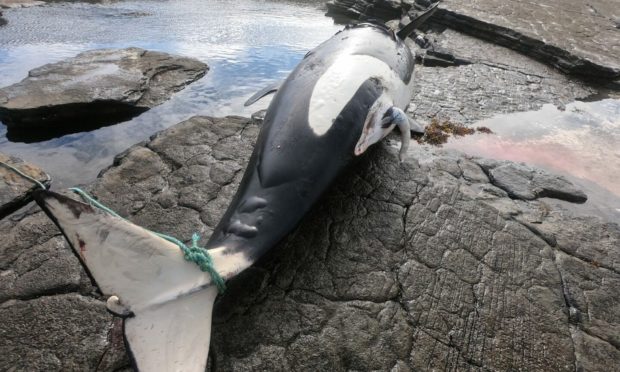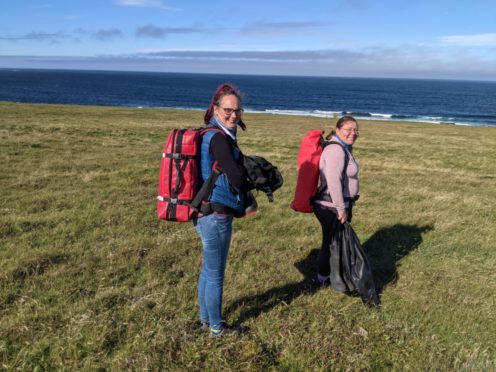After an orca was found dead and stranded on Papa Westray on Monday, research teams came together to try and find the cause of death.
The orca is believed to be a young member from the 27s pod which is frequently spotted around Orkney, Shetland and the north-east coast.
Members from Scottish Marine Animal Strandings Scheme (SMASS) and Orkney Marine Mammal Research Initiative (OMMRI) came together to carry out a comprehensive necropsy.
It found that the animal most likely died from entanglement in either active fishing gear or discarded material.
They were able to assume this because of distinct rope marks around the tail of the animal.
Entanglement
A full report of the investigation, published on the SMASS Facebook page, said it was most likely that the animal became entangled, was unable to get to the surface as a result and later drowned.
OMMRI were keen to stress that not all entanglements happen deliberately.
On their Facebook page they said: “Entanglements are an emotive issue but it’s important to remember that they are not deliberate – Orkney has a proud fishing tradition and many folk working within our marine environment are as excited to see cetaceans as the keen watchers from shore.”
However, for this kind of incident to be avoided in the future, fishermen, marine environment users, conservationists and government must come together to think of sustainable solutions.
Imogen Sawyer and Emma Neave-Webb are OMMRI Trustees and SMASS volunteer samplers.
Ms Sawyer said she hoped the orca’s death would highlight the change that needs to be made.
She said: “I’m hopeful that this death will not be in vain, that it will help to galvanise those invested in the marine environment to work together to bring about the change that we all know is needed to reduce the risk of entanglement, whilst still protecting the livelihoods of inshore fishermen.”
“Orkney waters are very keenly watched”
Ms Sawyer and Ms Naeve-Webb helped the SMASS team with both their initial sampling and their necropsy.
Ms Sawyer said that some areas of Orkney can be more prone to animal strandings.
She said: “Parts of Orkney make it easy for an animal to get ‘caught out’ by rapidly dropping tides or to simply become confused, as their echolocation doesn’t work so effectively where the sea bed is sandy.
“Anecdotally, it feels that the number of live strandings are increasing but we know that Orkney waters are very keenly watched, by residents and visitors, which helps hugely in improving the likelihood of a stranding being seen and reported.”
The pair had mixed feelings about the stranded orca, though both agreed that it was the worst smelling necropsy they’d ever done.
Ms Naeve-Webb said: “It’s incredibly sad we’ve lost a healthy young animal that we know and have seen regularly but, at the same time, it’s a huge learning opportunity to find out more about the general health of this pod and the Northern Isles Community killer whales.
“It sounds such a cliché but it really was a privilege to be able to help with the investigation into the death of this animal and personally a hugely interesting albeit incredibly emotional experience.”
What do I do if I find a stranded animal?
If you come across a stranded animal, whether it be a whale, dolphin or porpoise, the best thing to do is to contact call BDMLR on 01825 765 546 with details and a location.
They have of dedicated medics who are trained to respond to stranded animals.
OMMRI say that people should avoid trying to move the animal themselves, as they are likely to cause more harm to it.
The team also appreciate reports of any sightings of marine mammals, as it helps them track their movements and numbers.
Ms Sawyer said: “OMMRI records all sightings of cetaceans (whales, dolphins and porpoises) within Orkney waters in order to help build a better picture of what’s happening locally.
“We encourage anyone with a sighting to let us know about it via our website or by email at sightings@ommri.org.”

